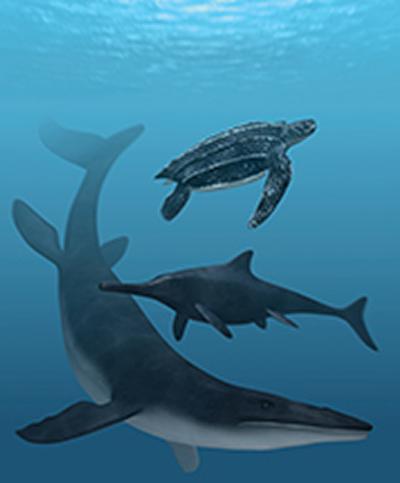Fossil pigments reveal the colours of ancient sea monsters

An international team of scientists has, for the first time, revealed the colour scheme of an extinct marine animal using fossilised skin pigment from three multi-million-year old marine reptiles.
Previously, scientists could only guess what colours huge reptiles, such as mosasaurs and ichthyosaurs had; however, pigment preserved in fossilised skin has now been analysed at SP Technical Research Institute of Sweden and MAX IV Laboratory at Lund University in Sweden. The unique soft tissue remains were obtained from a 55 million-year-old leatherback turtle, an 85 million-year-old mosasaur and a 196–190 million-year-old ichthyosaur.
Dr Gareth Dyke, Senior Lecturer in Vertebrate Palaeontology at the University of Southampton, was among the scientists that made the spectacular discovery. He says: “The most sensational aspect of the investigation is that it can now be established that these ancient marine reptiles were, at least partially, dark-coloured in life, something that probably contributed to more efficient thermoregulation, as well as providing means for camouflage and protection against harmful UV radiation.”
The results of the study by scientists from Denmark, England, Sweden and the USA are presented in the scientific journal Nature.
The analysed fossils are composed of skeletal remains, in addition to dark skin patches containing masses of micrometre-sized, oblate bodies. These microbodies were previously interpreted to be the fossilised remains of those bacteria that once contributed to the decomposition and degradation of the carcasses. However, by studying the chemical content of the soft tissues, the scientists were able to show that they are in fact remnants of the animals’ own colours, and that the micrometre-sized bodies are fossilised melanosomes, or pigment-containing cellular organelles.
“Our results really are amazing. The pigment melanin is almost unbelievably stable. Our discovery enables us to make a journey through time and to revisit these ancient reptiles using their own biomolecules. Now, we can finally use sophisticated molecular and imaging techniques to learn what these animals looked like and how they lived”, said Per Uvdal, one of the co-authors of the study, and who works at the MAX IV Laboratory.
Mosasaurs (98–66 million years ago) are giant marine lizards that could reach 15 metres in body length, whereas ichthyosaurs (250–94 million years ago) could become even larger. Both ichthyosaurs and mosasaurs died out during the Cretaceous Period, but leatherback turtles are still around today. A noticeable feature of the living leatherback turtle, Dermochelys, is that it has an almost entirely black back, which probably contributes to its worldwide distribution. The ability of leatherback turtles to survive in cold climates has mainly been attributed to their huge size, but it has also been shown that these animals bask at the sea surface during daylight hours. The black colour enables them to heat up faster and to reach higher body temperatures than had they instead been lightly coloured.
“The fossil leatherback turtle probably had a similar colour scheme and lifestyle as does Dermochelys. Similarly, mosasaurs and ichthyosaurs, which also had worldwide distributions, may have used their darkly coloured skin to heat up quickly between dives,” said Johan Lindgren from Lund University in Sweden and the leader of the international research team that studied the fossils.
If their interpretations are correct, then at least some ichthyosaurs were uniformly dark-coloured in life, unlike most living marine animals. However, the modern deep-diving sperm whale has a similar colour scheme, perhaps as camouflage in a world without light, or as UV protection, given that these animals spend extended periods of time at or near the sea surface in between dives. The ichthyosaurs are also believed to have been deep-divers, and if their colours were similar to those of the living sperm whale, then this would also suggest a similar lifestyle.